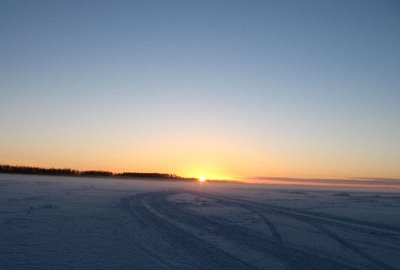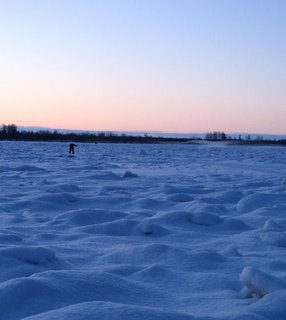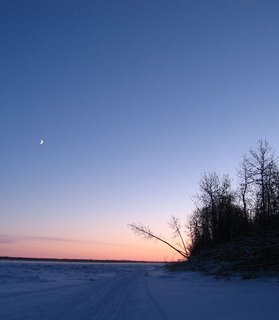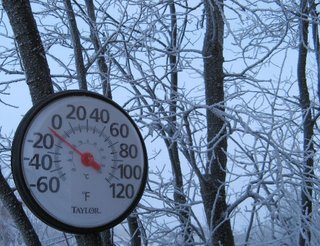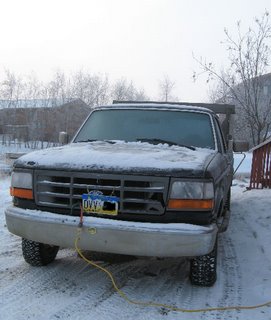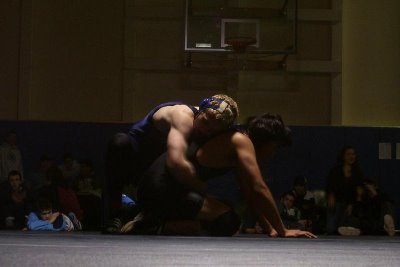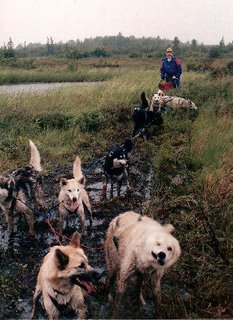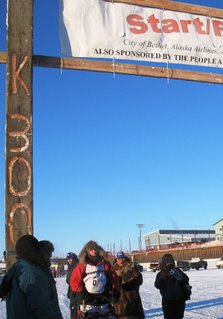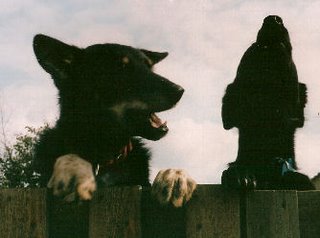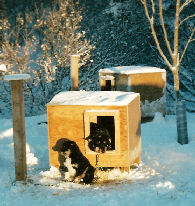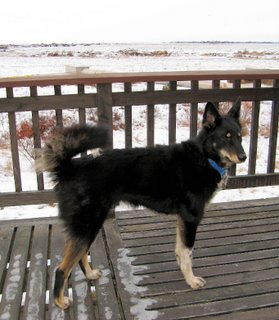Holiday Classic Sled Dog Race

The last weekend of the year is a big one for local sled dog racers. This is the weekend of the Holiday Classic, a 45-mile race from Bethel to above Akiachak and back. Most of the local mushers who plan to compete in the Bogus Creek 150 in three weeks run this race as a warm-up.
Henry’s niece Angela [previously known to readers of this blog as Andrea; I am now using her real name, so you can find her in the stats on the K300 web page] has been training a race team out of Henry’s yard for over two years now. She started with a group of puppies and has raised and trained them into a fine looking team. She has done a few races here and there, but nothing big and with a long training focus. This year she decided back in the summer that she would run the Bogus, and she has trained consistently and intensely for it ever since. The Holiday Classic would be her first real showing of the team.
Mike Williams, our pretty famous local Iditarod musher, has been training a large yard of dogs up in Akiak with the help of his handlers, his son Mike Jr, his daughter Shawna, and his nephew Gillbert. Shawna and Gilly are both running the Bogus, and brought teams down for the Classic. Mike Jr won the Bogus last year, so he gets free entry into the Kuskokwim 300 this year. He stayed in Akiak to run a three-day stage race this weekend, which would put more miles on his dogs.
Mike and family always stay at Henry’s place when they are in Bethel, and arriving with dog teams for a race is no exception. The dogs (sixteen in this case) are tied in the willow trees at the edge of a frozen slough next to Henry’s yard. Henry’s shop is right next to the dogs, and has a wood stove, a spare bed and plenty of floor space, so is very convenient for the visitors.
The race started at 11 am and was expected to take three to four hours before the winner would cross the finish line. It was a mass start, where all teams line up, the flag drops, and chaos ensues as teams surge forward over the icy frozen river. Mass starts are fun to watch, but can be hard on the teams and the mushers.
It was a beautiful day for sled dog racing. The thermometer read -10F and there was no wind. The sky was completely clear all night and the early morning darkness was quiet. Dutch and I showed up at Henry’s at 10 am to be the truck handlers for Shawna’s team. We loaded eight dogs and her sled in the back of my truck in the soft light of early dawn. Her team was composed of the older dogs in the yard. Almost all were five to eleven years old, and some had been on Mike’s Iditarod team four or five times. These are experienced racing dogs; they were all calm and easy to handle.
We drove the three teams in three trucks to the start line down on the river and were the first ones there. More trucks arrived quickly, and in all ten teams competed.
 Shawna got her sled placed with the ice hook firmly anchored in the river ice and the gangline stretched out in front. She and I put harnesses and booties on the eight dogs in the back of the truck, and then handed them off to Dutch, Mike and Gilly to hook up to the gangline in their running positions.
Shawna got her sled placed with the ice hook firmly anchored in the river ice and the gangline stretched out in front. She and I put harnesses and booties on the eight dogs in the back of the truck, and then handed them off to Dutch, Mike and Gilly to hook up to the gangline in their running positions.Once all the teams were lined up there was lots of barking, lunging (jumping forward in their harnesses, trying to take off), and high dog energy. They were all rarin’ to go. A countdown might have helped, as some mushers weren’t quite ready when the flag dropped, and then there was a scramble to get going. Angela, Shawna and Gilly all took off well. Fortunately there were no noticeable dog tangles anywhere along the start line, but the teams further out on the ice had to cross some slippery glare patches to get up to the bank where the trail was. In a minute they were all out of sight around the river bend.
Henry and Mike jumped into Mike’s truck as soon as they left and roared off to follow the race upriver. Angela’s husband and training partner Sean was on his snowmachine and took off overland to try to beat the race to Akiachak. Dutch and I considered trying to follow Mike’s truck, but decided against it. Mike drives like a banshee on the river, and my truck is older than his. We opted to go out for breakfast instead.
W
 e returned to the river just in time for the finish. First and second place were taken by two young mushers from Bethel, Jessica Klejka and Pete Kaiser. Jessica is 16 and has run the Junior Iditarod once; she plans to run it again in February. Pete is 20 and has run many local races. He won the Akiak Dash (50 miles) last year. Angela came in a strong third, and we were all very proud of her. Her dogs all looked strong and lively crossing the finish line. Shawna finished sixth and Gilly finished eighth. Everybody had a good race, solved a few problems, learned a few things. Experience is the best teacher.
e returned to the river just in time for the finish. First and second place were taken by two young mushers from Bethel, Jessica Klejka and Pete Kaiser. Jessica is 16 and has run the Junior Iditarod once; she plans to run it again in February. Pete is 20 and has run many local races. He won the Akiak Dash (50 miles) last year. Angela came in a strong third, and we were all very proud of her. Her dogs all looked strong and lively crossing the finish line. Shawna finished sixth and Gilly finished eighth. Everybody had a good race, solved a few problems, learned a few things. Experience is the best teacher.We had a celebration at Henry’s after the race and heard the tales of the trail from the mushers and observers. Angela had to stop several times in the early part of the race to deal with loose hardware on the gangline, and shortly before the half-way point, she was dead last. In the second half of the race, she managed to pass six teams to come in third. She was overtaking the second place finisher strongly, and Henry believed that if the course had been the full 50 miles it had originally been, she would have passed him too.
Everyone who saw her team in action on the trail used the same description: smooth. Once the hardware problems were solved, she was in the groove, and had the mental toughness to stay focused and competitive from last place. What a comeback!
The Kuskokwim 300 and the Bogus Creek 150 are 19 days away. The excitement builds…
Photos by Dutch and The Tundra PA. Mostly, we were so busy with dogs we didn’t have time to take pictures. For more photos and race stats on the Holiday Classic, go to www.k300.org.
Labels: Dog Mushing
